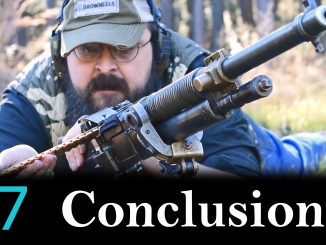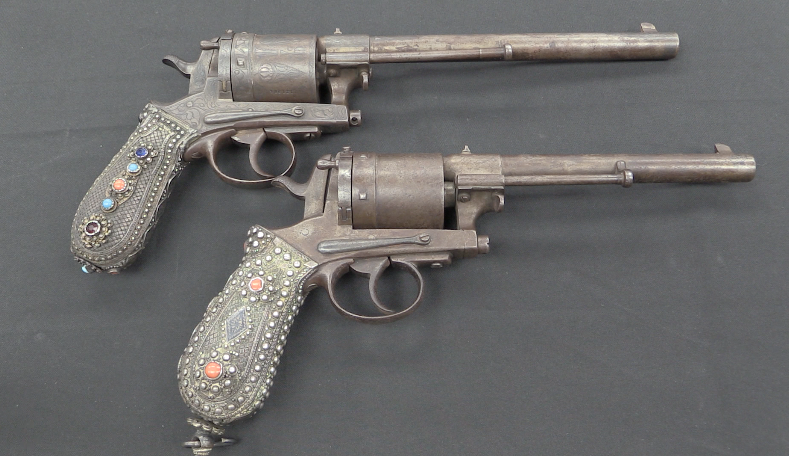The 1905 Steyr-Mannlicher was developed by Ferdinand Mannlicher, one of Europe’s most prolific gun designers. It uses the 7.65mm Mannlicher cartridge, which is roughly equivalent to .32 ACP, with a 10-round fixed internal magazine. The 1905 is, in my opinion, a fantastically elegant pistol, handles very well, and has minimal recoil thanks to its light cartridge. The ammunition used in this video is 1940s Argentine surplus (the single largest batch of pistols was sold to the Argentine Navy), which is known for having hard and dud primers (as you will see at the end of the video).
Mechanically, the pistol is a sort-of delayed blowback. It has a spring-loaded cam pushing against the breech that theoretically delays opening, but in practical fact it doesn’t have a significant impact. You can see how quickly the breech opens in the video…




Very nice video and a very interesting and esthetically pleasing pistol, but…
Why does it seem that all somewhat obscure 7.62mm or 7.65mm semi-auto pistol cartridges are said to be “basically equivalent to .32 Auto”? It was not true for the 7.65mm Long (.30 Pedersen) and it’s not true for the 7.65mm Mannlicher, either. Those two are very similar, though, and both are significantly more powerful than .32 ACP. They launch a heavier bullet at a higher muzzle velocity than even the most powerful .32 ACP loadings for about 30-50% more muzzle energy, which is similar or even somewhat higher than .380 ACP.
I haven’t chronographed the Mannlicher, but my understanding is that it produces about 1,000 fps (with an 85 grain bullet). That would put it between .32 and .380.
Admittedly, neither have I, but most sources I have seen say 310-340 m/s. Even if it’s only 1000 fps (≈ 305 m/s, E0 = 257 J / 189 ft-lbf), it would put it pretty firmly in the (lower) .380 ACP territory.
On a subject of obscure 7.62mm cartridges: have you noticed that Fiocchi USA loads the 7.62mm Nagant to what is very much like the Russian/Soviet military load:
http://www.fiocchiusa.com/index.php?option=com_content&view=article&id=296&Itemid=183
This load is not available in Europe, probably because it exceeds the CIP specifications. In any case, now it’s time to recover your Nagant from the ditch you threw after the two gun match 😉 and redo the match with more potent ammunition. I’m pretty sure the plates would fall better with the Fiocchi ammo 😀
Wasn’t the 7.65×21 Mannlicher done with objective of “most powerful cartridge that can be handle by blow-back pistol of reasonable size”?
“one of Europe’s most prolific gun designers”
There was also experimental Mannlicher’s self-loading carbine chambered for 7.65×32 Mannlicher cartridge: http://www.municion.org/7mm/7_65x32PistolenKarabiner.htm
Dimensionally it is similar to .30 Carbine, but I don’t know ballistic data for it. IIRC this carbine was up-scalled Mannlicher Selbstlade-Karabiner Model 1901, but I am not sure.
That 7.62×32 Man. is one elegant shot. Probably not far from modern and trendy .300 BLK.
I agree with your appreciation of its fantastic looks. It is, to quote Obi-wan, ‘An elegant weapon for a more civilized age.’
Some of the early Star automatics, notably the Military Model #1, were externally patterned on the Mannlicher;
http://picturearchive.gunauction.com/4241203238/10498616/picture%20931.jpg_thumbnail0.jpg
Internally, they were typical Eibar straight blowbacks. During WW1, large numbers of these in 7.65mm Browning (.32 ACP) were used by the French, along with everything else the French Army could scrounge everywhere.
The 6.35mm Model 1908 also had the “Mannlicher look”;
http://unblinkingeye.com/Guns/StarCO/Star1908CatS.jpg
Which sort of conflicts with the whole concept of a “pocket automatic”, when you think about it.
cheers
eon
The other one I like is the Italian Lira, which copied the mechanism but used a detachable magazine in place of the fixed one.
Lira was Spanish, IIRC Garate Y Cie
Yes, and it’s not surprising, as they all had the same designers;
The Eibar makers tended to copy whatever was popular at the time. Later on, they copied the Colt 1911 (Llama Extra, Star Super, etc.).
I can only assume that before WW1, the Ster-Mannlicher pistol was a hot property in Europe. It wouldn’t be surprising when you consider how little serious competition there was at the time. Once you subtract John Moses Browning’s designs from FN and Colt, the remainder were fairly big, bulky pistols like the Mauser c/96 or ultra-small pocket guns in .25 ACP. The Parabellum wasn’t on the market yet, so there was a definite “market segment” for pistols like the Steyr-Mannlicher and its Spanish “lookalikes”.
Come to think of it, the oddball Spanish Jo-Lo-Ar blowback, with no triggerguard and that freaky-deaky cocking bar hinged to the slide, looks a lot like the Steyr-Mannlicher “impersonators”, even though it arrived a decade later (mid-1920s).
Maybe imitation is the sincerest form of flattery.
cheers
eon
The second reference did not pan out, but the first one is gorgeous gun. Someone should make them over again, as many others are made novadays.
Try the link in my reply to bojan. It goes to the same page.
cheers
eon
Another one of those beautiful pre-WWI “John Carter of Mars” semi-autos. It, and the 6.5mm Bergmann are indeed elegant to a fault. I wish there were modern reproductions of both in .32acp.
I been looking for some detailed views and found this: http://www.wehrmacht-awards.com/forums/showthread.php?t=379226
It does not shot the delay-lever though.
Ian,
Always liked this pistol’s look, and after your article a couple of years ago, found and bought one. the hard primer argentinian rounds are to be believed and so ordered some 7.65 ammo from buffalo arms (that was two years ago!!)finally found the book, “tricks of the trade” by J.B.Wood. fitted the pistol with a sleeve from a steel .30 carbine case, and now blast away at fundamentalist, not quite terrorists, that subscribe to civilian beheading, while calling out in some foreign tongue what may amount to some diety of theirs. all the while reloading and bringing “natural borne smoke” upon them. and, most importantly, not ofending the current administration.
that’s the truth and I’m stickin to my story!
This pistol is also the forerunner of “Slide back passed over the fixed barrel type take down handguns” that the most known samples of which are blowback Walther models.
Spring actuated delay systems generaly less effecting slow mechanisms since supposed delay time divides into half by cause of two recoil responsing elements acting opposite directions at instant of firing. .45″ACP Thomas is another sample of this approach. It uses hand squezze instead of spring however.
Hi Strongarm!
I looked at some disassembly and shooting videos. It looks well made but impossibly awkward from manufacturing point of view. Slide is something which starts like block of material and gets gradually hogged out till shell is left. It can be made differently, but at 1905 level of technology, I doubt. Take care!
Hi, Denny,
Those Mannlicher pistols are piece of arts. The designer, probably the most fertile firearm genius of all time, had worked the layout like laces. But friction type delay systems supported by spring force, are not quite effective. Mannlicher’s is located at right side at under the slide end as filling a small cut under tension of upper arm of main spring. At instant of firing, the frame jumps forward as affected by temporary plugging of forwarding bullet and slide starts to move to opposite direction as being pushed back by empty case and, the mainspring through inertia, may not adapt itself even if its elasticity to manage lodging its cammed cut within twice speed time interval. Another similar attempt by a Spanish pistol “Campo Giro” was made later as using coil spring with much worse results. Known last example was a small .45″ ACP pistol, “Thomas” as using a lever in shape of a grip safety and inserting in a cam under the slide when squezzed. The tackle seemed as working but in fact, the short barrel needed no additional breech closing mechanism rather than slide mass. Care.
“It looks well made but impossibly awkward from manufacturing point of view.”
Which automatic pistol can be manufactured faster: Mannlicher 1905 or Krnka 1907?
I think when quite awkward nowadays the Mannlicher was not much different (in terms of manufacture) from other fire-arm of early 20-th century.
Funny word to pronounce in in English, Mannlicher: Mann’lich’er Mann’lic’her Mannl’ich’er, kinda sounds like man licker… If you go for the first one, I’ve always thought it was more appropriate to say man itcher.
Nice gun, elegant etc, makes a great sound too out there!
Man litch, man lic… Anyway I digress.
Try Man-leech-er, maybe it will go better. That’s the one who is giving Leech therapy. http://www.leechestherapy.com/benefits_and_effects.php
Man leecher, Mon leeker, man itcher, man licker… Hmmm, he he.
….and, every gun is basically “man-kicker”. That’s the reason for saying ‘kick-the-butt’.
Correct pronunciation AFAIK is “MON-leeker”. The “N” sound isn’t really “doubled” or drawn-out, it actually cuts off a bit sharpish.
As for the other half as applied to rifles, “Schoenauer” is best pronounced “SHOW-now-er”. Some say it’s properly “SHAY-nowr”, but some German-speakers in my family (including a couple of Mannlicher owners who acquired them while “on tour” in the region wearing OD in 1944-45, IYKWIM) looked at anyone who said it like that very oddly indeed.
😉
cheers
eon
One of my favourite guns! 🙂
The first time I came across it was in the old ITV-series “Reilley, Ace of Spies” (starring Sam Neill):
http://www.imfdb.org/wiki/Reilly:_Ace_of_Spies#Mannlicher_Model_1905
In one episode Reilley buys his bodyguard (a woman) said pistol. And the seller in the shop tells him, that it is in a “rare” caliber, but he fortunately has a few boxes of ammunition for sale.
Always wondered what a (nice) gun this was! Until I came across it (once again) many years later.
There was also a Spanish Version of the this pistol that was nearly Identical, but used a curved removable magazine.
Hey you guys! Do you not think that bearded guy from the Military arms channel on full30 has a doppelganger, watch this:
https://www.youtube.com/watch?v=xYX-k1r2DLQ
Gonnie nae do that?
“How?”
How – means why out of interest, in this context.
We(others as well I believe) have silly “rhyme” that goes something like that: “sicher ist sicher” said Mannlicher – and invented safety 😉
I took my 1905 Mannlicher pistol out yesterday to the range. I do have a box of the old Argentine rounds, they even came with the “Packed by so and so” enclosed in the box…amazing. Anyway, there is brass already available for the 7.65 Mann. 3 different companies make the reloading dies (I used the CH4D dies, they were the cheapest at $103). I used the Speer 7.65 bullets and tried 2 different loads…one of 2.6 grains of Unique, and one of 3.2 grains of Unique. Both worked great, so I’ll be using the 2.6 for less pressure on the pistol.
Main pain….the brass is tossed 8′ straight to the rear…what a pain that is. Finding small brass cases is a challenge. The rest of the shooting was done in the “Pimp technique”…basically holding the pistol horizontally so the brass went into the open catcher. After all, this was just testing for function.
One very neat item….when the bolt is back you can safely load a single cartridge into the magazine…and the bolt doesn’t shoot forward (e.g. like a broomhandle will do)…andyway, you slightly pull the hammer down and the slide closes…beautiful design. So, have the pistol, an original holster, 2 stripper clips and an original box of shells….got the full set. Goes great with my 1905 Mann. rifle in 9×56.